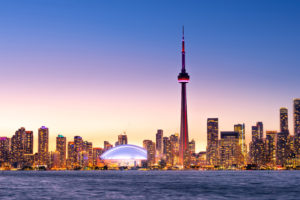Keeping interior spaces cool in summer is much less energy- and carbon efficient than heating them in winter. For this reason, most of the CALGreen provisions for making buildings energy efficient relate to HVAC. With climate change, maintaining livable temperatures at a reasonable carbon footprint is increasingly difficult. Deep water cooling offers an elegant solution.
How deep water cooling works
In a large building with central air conditioning, cold water circulates in the cooling system. Normally the building will have a refrigeration unit that chills the water. However, refrigeration is notoriously complex, inefficient, and energy intensive. It also requires refrigerants, which are not environmentally friendly.
Deep water cooling replaces the refrigeration unit with a large supply of naturally cold water. Usually that would be a nearby lake. Instead of compressing a refrigerant and pumping it through cooling coils to condense and then remove heat from the circulating water, a heat exchanger directly transfers heat to the cold lake water. The energy to operate the pumps and the heat exchanger is much less than a refrigeration unit consumes. In addition, heat exchangers don’t use refrigerants.
The energy to operate the pumps can be further reduced by designing the piping to make use of siphoning. Once it starts flowing, the water doesn’t need much additional energy to keep moving—just enough to overcome friction.
In principle, you need only one circuit of piping to convey the water from the lake into and through the building. However, deep water cooling systems involve more than one circuit. That allows for separation of water in the building from water in the lake, which prevents cross contamination. Where water is circulating to several buildings around a campus or a municipal district, there might be a separate circuit for that.
Cornell University
Cayuga Lake provides the cold water for a district cooling loop that serves the campuses of Cornell University and Ithaca High School. This district loop is closed so that the warm water flowing downhill to the heat exchanger can help push the cold water from the lake to the campus.
The lake water flows in an open loop to the heat exchanger, where it cools the water in the district loop. It then flows to the outfall. Except in winter, the water from the outfall is cooler than the surface water. However, dispersion minimizes the effects of introducing warmer water back into the lake.
Over all, this system represents an energy savings of 85% compared to conventional refrigeration.
Downtown Toronto

Lake Ontario provides both drinking water and air conditioning for the city of Toronto. The water near the bottom of the lake remains at just above freezing temperatures year-round. Three intake pipes transport the water from the lake to a filtration plant. It then flows to the heat exchangers, where it cools the water from the air-conditioned buildings. From there, it proceeds to the city’s potable water system for treatment and use.
Because Lake Ontario was already the source of the city’s drinking water, there’s no real difference in the quality of the water that returns to the lake. The new system takes colder water from deeper in the lake than the old system. However, each winter the supply of cold water is replenished.
The deep water cooling system can cool 100 buildings at a savings of up to 90% of the energy for conventional air conditioning. It also saves 43,000 kg of ozone-depleting CFCs, as the heat exchangers don’t use refrigerants. In addition, the water from the depths of the lake is cleaner than the water previously used for drinking, so it needs less chemical treatment.
For locations that don’t have a handy reservoir of water, passive radiative cooling is a possibility.
